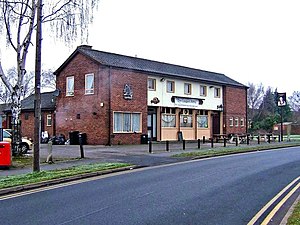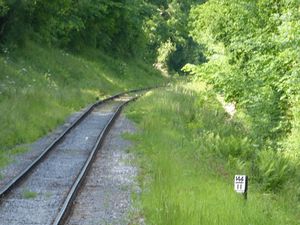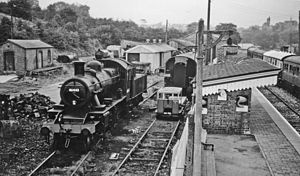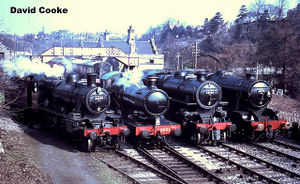Severn Valley Railway Timeline 1965-1969
Significant events in the history of the Severn Valley Railway in preservation between 1965 and 1969 are set out below.
Contents
Contents
1965
The formation of the Severn Valley Railway in preservation began on 6 July 1965. Keith Beddoes, a local railway enthusiast, organised a meeting at the Cooper’s Arms in Kidderminster to discuss the feasibility of preserving a section of the former GWR Severn Valley Railway which had been closed by British Railways (BR). Around 50 people attended the meeting, and those present agreed to form the Severn Valley Railway Society (“the Society”). The initial membership subscription was proposed as £1, but eventually set at 1 guinea (£1+1shilling) at the suggestion of John Garth, in order to increase funds.
Two other possible locations were also considered for the potential preserved railway. One option was to use a section of the Tenbury Branch between Bewdley and Cleobury Mortimer. However this was not feasible because BR were still using Bewdley station at that time and could not grant access. Another option would have been the Cleobury Mortimer and Ditton Priors Light Railway; however this was deemed unsuitable because of its remoteness and the relatively light axle load limits of the light railway. The Severn Valley Railway south of Bridgnorth thus became the Society’s goal.
On Sunday 11 July the Society visited Bridgnorth Station. While holding up the old station name board to take a photograph, they were challenged “What the hell do you think you are doing?” by a man with a shotgun. This turned out to be George Thorpe (also known as ‘Elias’) who had continued to operate the station refreshment room after the station itself had shut. Once the Society explained their idea, they were quickly made welcome!
On 25 July, the Society made a second visit to inspect the line between Hampton Loade and Bridgnorth. They discovered that since their first visit, BR had begun to take up the track from Bridgnorth Station towards Kidderminster. The Society authorised John Garth to send a telegram to British Rail asking them to stop taking up the line, which they fortunately agreed to do while negotiations took place.
The Society’s initial goal was to operate services over the 4½ miles between Bridgnorth and Hampton Loade. However the Society would also need to take on the track between Hampton Loade and Milepost 144½ near Alveley in order to maintain a connection to the main line via the section beyond, which BR was still using for colliery traffic from Alveley Colliery. At a meeting in August, the Society proposed to lease the line from BR.
BR granted the Society access to the Bridgnorth Station site in exchange for a rent of £5 per month, and regular Sunday afternoon de-weeding of the track and painting of the buildings began.
In September 1965 the Stephenson Locomotive Society visited Alveley with a special train from Bewdley, hauled by GWR locomotives 4555 and 1420. This helped publicise the preservation scheme.
1966
BR proved unwilling to lease the line to the SVR, and initially quoted a price of £45,000 for the outright purchase of line between Bridgnorth and Milepost 144½ at Alveley Colliery. However following a professional valuation the Society made an offer of £25,000 for the track and buildings, which BR accepted in February 1966. BR asked for a deposit of 10% against the purchase price.
The rest of 1966 was taken up with raising the deposit. Bridgnorth Station saw regular ‘open weekends’, the first being a steam-free information display as part of Bridgnorth Arts Festival, over the Whitsun bank holiday weekend.[1] Two further open weekends later in the year featured road traction engines and a miniature railway set up on Platform 2. Society membership grew to around 300 in the first year.
During 1966 the Society learned that operating authority from the Ministry of Transport would be required before the Railway could be bought from BR. BR would need to apply for a Railway Order to downgrade the line from “secondary railway” to “light railway” status. Once this was granted, a new Company would need to apply for a Light Railway Order (LRO) to transfer responsibility for the line; the Society itself not being able to apply for legal reasons. Severn Valley Railway Company Limited, ‘the Guarantee Company’ (being a Private Company Limited by Guarantee), was incorporated on 24 May 1967 in order to make the application for the LRO at the appropriate time. However the company remained dormant for the next 2 years, with the Society continuing to conduct the negotiations with BR.
1967
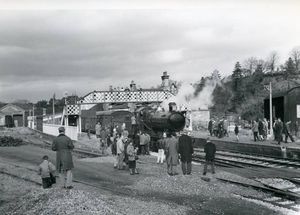
The Society paid the 10% deposit to BR in February 1967, with contracts for the purchase being exchanged on 1 June (the balance of the purchase price was paid shortly after the official opening in May 1970). BR allowed stock to be moved in once the 10% deposit was paid, and the preservation scheme really gained momentum with the arrival on 25 March of the first locomotive and 4 GWR coaches including GWR 6562 which is still at the SVR. GWR 0-6-0 No 3205 had made the journey in steam from the BR shed at Stourbridge Junction, where it had been re-assembled after being hauled ‘dead’ from the West Country. Another 3 locomotives and a diesel railcar would arrive during 1967: Ivatt 2MT No 46443 on 22 April, GWR Railcar 22 on 13th May, Manning Wardle contractors engine no 2047 (later named Warwickshire) on 22 October, and ex-Port Talbot Railway 0-6-0 No 813 on 25 November.
The availability of working rolling stock saw a succession of steam galas in 1967. The Railway had not yet received the Light Railway Order allowing rides to be given to the general public. However SVR members could travel, so the Railway did a brisk trade in ‘Day Member’ tickets, while full membership of the Severn Valley Railway Society also benefitted, passing the 1,000 mark by the end of the year.
During 1967 the Civil Engineering Department constructed a 30ft long locomotive inspection pit at Bridgnorth. A water tower was purchased from Dudley and erected at Eardington, the only source of suitably soft water on the line.
The excitement of the time was tempered by the news that Shropshire County Council and several local Parish Councils were likely to oppose the formal re-opening of the Railway, as it might prejudice the proposed construction of the Bridgnorth By-pass and the carrying out of road improvements relating to bridges in the Eardington area. However BR remained supportive of the SVR, allowing continued tenancy of Bridgnorth Station.
The first locomotive to arrive, ex-GWR 3205, approaches Bridgnorth on 25 March 1967 (Sellick Collection)
A large crowd greets 3205 on arrival Bridgnorth on 25 March 1967 (Sellick Collection)
1968
The galas continued with the tacit approval of BR. The Easter Steam Gala featured No 3205, while the Autumn Gala saw 10,000 visitors to Bridgnorth, with 3205 and 46443 making alternate trips to Hampton Loade and back. Over £1,000 was raised on that Bank Holiday alone. However BR, which was still the LRO holder, became concerned at safety at such sizeable events.
The year saw the arrival of 3 more engines; LMS 3F Jinty 0-6-0 No 47383 on 26 May, Ex-Hams Hall Power Station Peckett 0-4-0ST No 1738 on 13 July and Ivatt 4MT Mogul 43106 on 2 August.
Negotiations with Shropshire County Council and the other dissenting parties proved fruitless, and a Public Enquiry became necessary to consider the proposed Scheme for the Railway. This was held in October 1968 at County Hall in Shrewsbury. BR gave backing for the Railway, and many other witnesses were called. The plans put forward for the bypass and evidence on road usage appeared to those present to be hastily put together. On the second day of the Enquiry, the Inspector and all parties travelled from Bridgnorth to Bewdley to view the Scheme at first hand. The Minister of Transport’s decision would be based on the Inspector’s report.
1969
1969 saw the arrival of another 2 engines; LMS Stanier 8F No 48773 [LMS 8233] on 4 January and ex Manchester Ship Canal and ICI Hunslet 0-6-0T 686 The Lady Armaghdale on 14 July.
Alveley Colliery closed in January 1969, following which BR officially closed the adjacent section of the line from Alveley to Bewdley. Technically the area north of Bewdley was a closed siding under BR control and therefore subject to the recently imposed BR steam ban. Early in 1969, BR banned steam operations by the SVR, a blow which made the SVR members all the more determined to re-open the line.
Around this time, the SVR Society rented the former goods-shed and yard at Bewdley. This space would be used for restoration of locomotives and rolling stock, 4566 and 1501 being among the earliest residents.
The result of the Public Enquiry was a recommendation by the Inspector that the first LRO should be granted. However in June 1969 the Minister of Transport rejected the recommendaton, citing the potential extra cost to public funds of the Bridgnorth By-pass Bridge if the Railway went ahead (the objections relating to the Eardington road bridges were not sustained). The Minister invited the parties to meet and resolve the issue. In order to make progress, it became necessary for the SVR to agree formaly that they would either fund the By-pass Bridge or end the line south of the By-pass when and if it was built. Given that assurance, the County Council withdrew its objections and the Minister accordingly found in favour of the Scheme.
In December 1969 the Severn Valley Railway Society was merged into The Guarantee Company, with the latter now becoming the proper entity to take the Scheme forward. The AGM coincided with the announcement that the first LRO had been granted, allowing BR to work the line from Bridgnorth to Alveley as a Light Railway, although of course they had no wish to do so. However the granting of that order meant The Guarantee Company could now apply for the second LRO to transfer ownership to the SVR.
See also
References
Past editions of Severn Valley Railway News. Also early history taken from:
- Severn Valley Railway Guide 1972/3, DN Cooke and DC Williams.
- SVR News 151 “The fortieth anniversary, Wednesday 6 July 2005”, text of a speech by Christopher George.
- Severn Valley Railway Steam, Sir Gerald Nabarro, M.P. (1971).
- Heritage Railway Magazine article
- ↑ A. G. Cleaver, "The Early Days Of The 'Severn Valley'", SVR News 190 (2015), p.24
